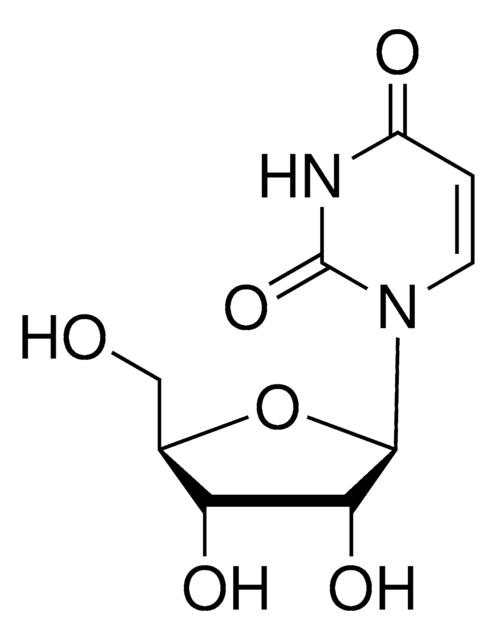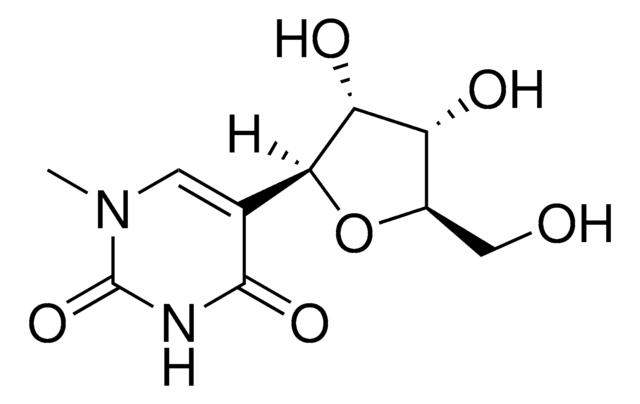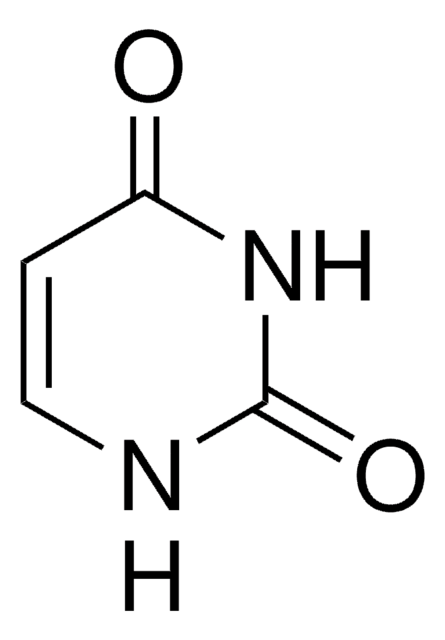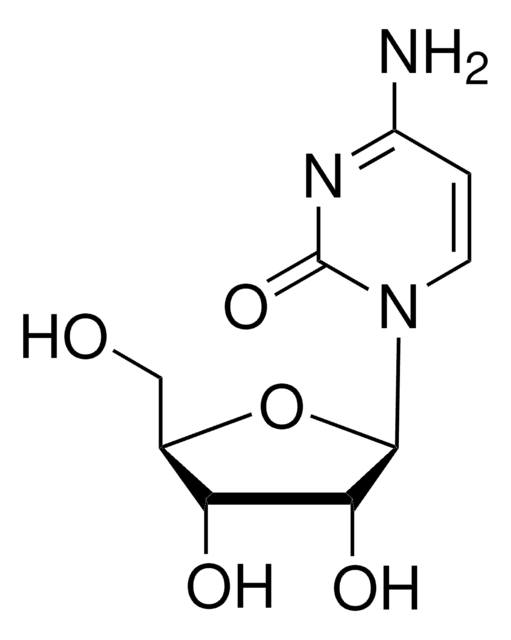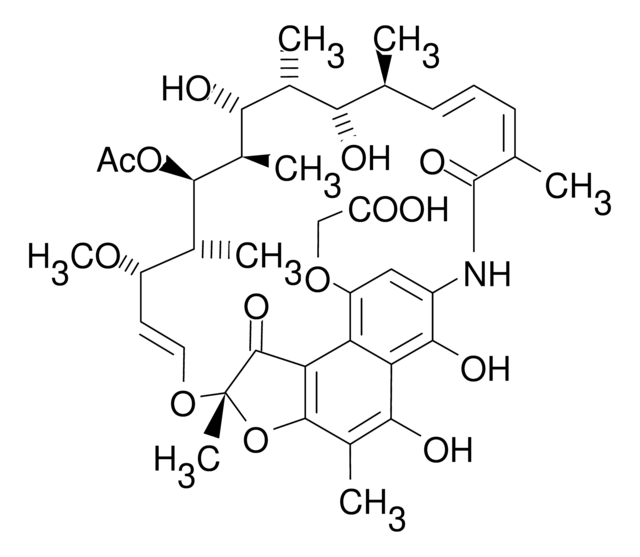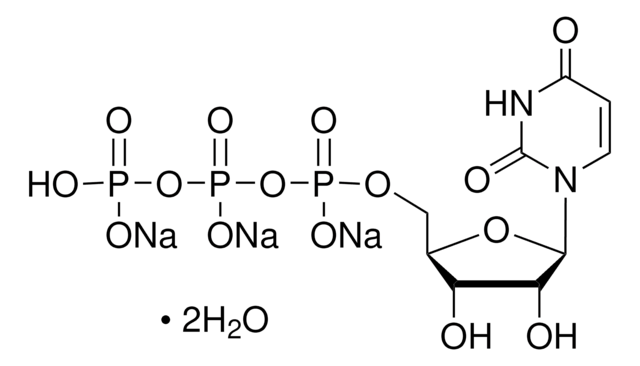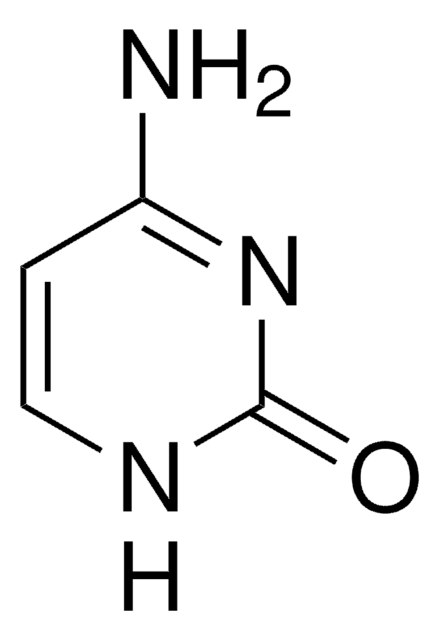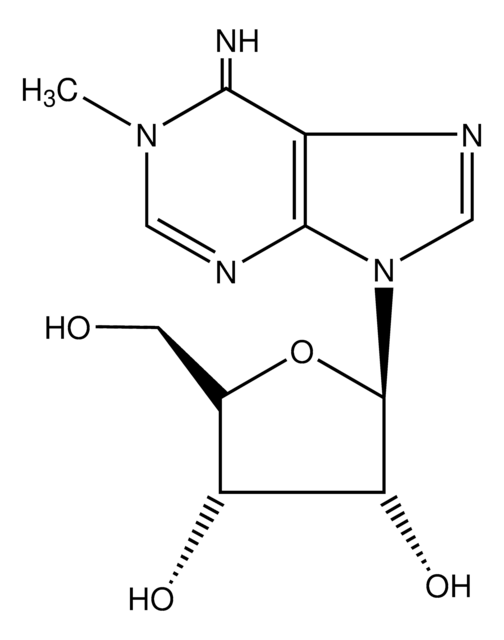추천 제품
생물학적 소스
synthetic (chemical)
Quality Level
분석
≥98% (HPLC)
양식
powder
분자량
244.2
색상
white to off-white
mp
222 °C ((432 °F ))
solubility
water: soluble
저장 온도
2-8°C
SMILES string
[nH]1[c]([nH]cc([c]1=O)[C@@H]2O[C@@H]([C@H]([C@H]2O)O)CO)=O
InChI
1S/C9H12N2O6/c12-2-4-5(13)6(14)7(17-4)3-1-10-9(16)11-8(3)15/h1,4-7,12-14H,2H2,(H2,10,11,15,16)/t4-,5-,6-,7+/m1/s1
InChI key
PTJWIQPHWPFNBW-GBNDHIKLSA-N
일반 설명
Pseudouridine (Ψ) stands as an isomer of the nucleoside uridine, featuring a carbon-carbon bond instead of the typical nitrogen-carbon glycosidic bond connecting uracil. It represents the most prevalent among the myriad modified nucleosides within RNA, with a presence spanning various species and RNA classes. The enzymatic action of Ψ synthases induces post-transcriptional isomerization of specific uridine residues, a process known as pseudouridylation. This modification, particularly in rRNA and tRNA, plays a vital role in fine-tuning and stabilizing regional structures, contributing to mRNA decoding, ribosome assembly, processing, and translation functions. Moreover, β-pseudouridine, identified in tRNAs across bacteria, archaea, and eukaryotes, has demonstrated potential in reducing radiation-induced chromosome aberrations in human lymphocytes. Its utility as a cancer and proliferation biomarker positions it as a valuable asset in metabolomics and biochemical research.
Pseudouridine is a C-glycosyl pyrimidine that consists of uracil having a β-D-ribofuranosyl residue attached at position 5. The C-glycosyl isomer of the nucleoside uridine. It has a role as a fundamental metabolite. Pseudouridine is found in all species and in all classes of RNA except mRNA. It is formed by enzymes called pseudouridine synthases, which post-transcriptionally isomerize specific uridine residues in RNA.
애플리케이션
Pseudouridine is a versatile compound and a biomarker that finds application in metabolomics and biochemical research.
특징 및 장점
- High-purity compound suitable for a wide variety of research applications
기타 정보
For additional information on our range of Biochemicals, please complete this form.
To gain a comprehensive understanding of our extensive range of Monosaccharides for your research, we encourage you to visit our Carbohydrates Category page.
Storage Class Code
13 - Non Combustible Solids
WGK
WGK 3
Flash Point (°F)
Not applicable
Flash Point (°C)
Not applicable
가장 최신 버전 중 하나를 선택하세요:
Mohammad Ariful Islam et al.
Biomaterials, 266, 120431-120431 (2020-10-26)
Synthetic mRNA represents an exciting cancer vaccine technology for the implementation of effective cancer immunotherapy. However, inefficient in vivo mRNA delivery along with a requirement for immune co-stimulation present major hurdles to achieving anti-tumor therapeutic efficacy. Here, we demonstrate a
Ryota Kurimoto et al.
The EMBO journal, 39(20), e104708-e104708 (2020-09-15)
Let-7 is an evolutionary conserved microRNA that mediates post-transcriptional gene silencing to regulate a wide range of biological processes, including development, differentiation, and tumor suppression. Let-7 biogenesis is tightly regulated by several RNA-binding proteins, including Lin28A/B, which represses let-7 maturation.
Matthias Heiss et al.
Nature communications, 12(1), 389-389 (2021-01-17)
Recently, studies about RNA modification dynamics in human RNAs are among the most controversially discussed. As a main reason, we identified the unavailability of a technique which allows the investigation of the temporal processing of RNA transcripts. Here, we present
Tingting Jiang et al.
Nature communications, 11(1), 1979-1979 (2020-04-26)
CRISPR-Cas9-associated base editing is a promising tool to correct pathogenic single nucleotide mutations in research or therapeutic settings. Efficient base editing requires cellular exposure to levels of base editors that can be difficult to attain in hard-to-transfect cells or in
Tatsuro Hagi et al.
Applied microbiology and biotechnology, 104(24), 10641-10653 (2020-11-08)
Akkermansia muciniphila is a prominent member of the gut microbiota and the organism gets exposed to bile acids within this niche. Several gut bacteria have bile response genes to metabolize bile acids or an ability to change their membrane structure
자사의 과학자팀은 생명 과학, 재료 과학, 화학 합성, 크로마토그래피, 분석 및 기타 많은 영역을 포함한 모든 과학 분야에 경험이 있습니다..
고객지원팀으로 연락바랍니다.